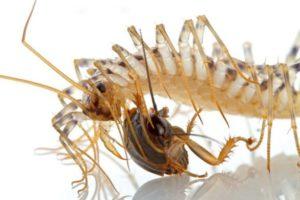Centipede flycatcher: an unpleasant sight, but a great benefit
In private houses and apartments, you can find an insect that moves quickly, rather long with a large number of legs. At first glance, it appears to have two heads. This is a flycatcher from the arthropod family, it also lives in the garden under the trees, in fallen leaves and hunts for various small insects: fleas, moths, flies, cockroaches, crickets.
Content
What does a flycatcher look like: photo
Description of the flycatcher
Name: Common flycatcher
Latin: Scutigera coleoptrataClass: Gobopoda - Chilopoda
Squad: Scoogitters - Scutigeromorpha
 | Habitats: | temperate and tropical climate |
 | Dangerous for: | flies, cockroaches, fleas, moths, mosquitoes |
 | Features: | the fastest centipede |
The common flycatcher is a centipede, whose scientific name is Scutigera coleoptrata, reaches a length of 35-60 cm.
The body is brownish or yellowish-gray with three longitudinal bluish or red-violet stripes along the body. On the legs are stripes of the same color. Like all insects from the arthropod family, the flycatcher has an external skeleton of chitin and sclerotin.
The body is flattened, consists of 15 segments, each of which contains a pair of legs. The last pair of legs is the longest, in females it can be twice the length of the body. These legs are thin and look like antennae, so it is not easy to determine where the head is and where the back end of the body is. The first pair of legs (mandibles) serves to capture prey and protect.
False compound eyes are located on both sides of the head, but they are motionless. The antennae are very long, and consist of 500-600 segments.
Food
The flycatcher preys on small insects. She moves very quickly, up to 40 cm per second, and has excellent eyesight, which helps her quickly overtake the victim. The flycatcher injects poison into its prey, kills it and then eats it. She hunts day and night, sits on the walls and waits for her prey.
In the warm season, the flycatcher can live in the garden, in fallen leaves. With the onset of cold weather, she moves into a dwelling, prefers damp rooms: basements, bathrooms or toilets.
Reproduction

The male flycatcher deposits a lemon-like spermatophore in the presence of a female and then pushes her towards him. The female picks up the spermatophore with her genitals. She lays about 60 eggs in the soil and covers them with a sticky substance.
Newly hatched flycatchers have only 4 pairs of legs, but with each molt their number increases, after the fifth molt the adult becomes 15 pairs of legs. The life span of insects is 5-7 years.
Flycatchers that live in the tropics are different from their relatives. They have slightly shorter legs and do not settle indoors.
Danger to humans and animals
Flycatchers living in human dwellings do not harm food and furniture. They do not attack, and can bite only as a last resort, for the purpose of self-defense.
Their jaws cannot pierce human skin, but if the flycatcher manages to do this, then its bite is similar to bee sting.
The poison, which can kill other insects, can cause reddening of the skin and swelling at the site of the bite in humans. It is also not dangerous for pets.
The benefit of the flycatcher is that it destroys flies, fleas, cockroaches, moths, termites, spiders, silverfish and is considered a beneficial insect. Many do not like its appearance and when a flycatcher appears, they try to destroy it. Although in some countries the common flycatcher is protected.
The common flycatcher is listed in the Red Book of Ukraine.
Conclusion
Although the common flycatcher has an unattractive appearance and runs fast, it does not pose any danger to humans and domestic animals. the flycatcher is not aggressive and does not attack first, but rather tries to quickly run away when it sees a person. The benefit is that, having settled indoors, she preys on flies, fleas, cockroaches, moths and other small insects.
